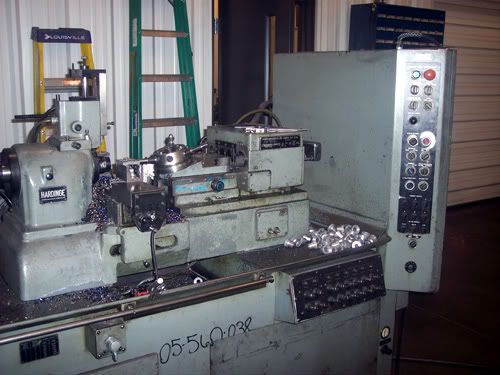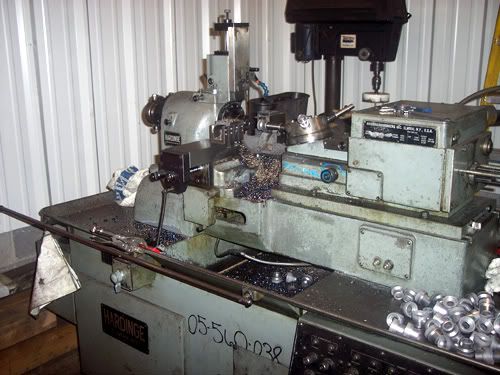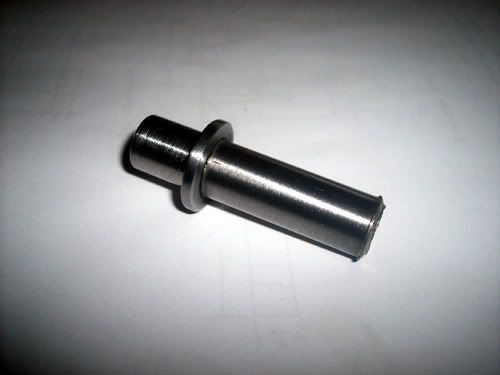rake60
Well-Known Member
- Joined
- Jul 8, 2007
- Messages
- 4,756
- Reaction score
- 124
In my thread Sent Home From Work to Work I show making parts for a machine at work.
I thought some of you might be interested in seeing the machine.
It's a 1970's Era, Hardinge DSM-A Automatic Turret Lathe.


The wear around the buttons on the control panel prove the machine's "experience".
Automatic then meant something other than what it does today.
It runs off micro switches and mechanical relays. When a cross slide is programed to run
it feeds in until a threaded adjustment rod contacts it's micro switch, then it returns to it's
home position. An adjustable hydraulic valve controls how far it rapids in before going into the feed speed
that is set by another adjustable hydraulic valve. The return speed is controlled by a third valve knob.
Are you following this? ???
The 6 position turret infeed depths are controlled by another micro switch system and 6 adjustable rods.
The "Programing Unit" is even more entertaining.
Little cam lugs on a rotating nylon drum are moved to the right to enable an action for a cross slide or other
tool slide. Moving the cam to the left disables that tool for that position.
Then there is a smaller rotating drum below that with adjustable cam stops on it. The turret rapids until
the roller hits one of the cam stops. Then it slows to the feed set by another set of adjustable hydraulic slides.
Maybe this will help to make sense of all that:
[ame]http://www.youtube.com/watch?v=PryGRXo-J5o[/ame]
It sounds pretty antiquated but it works very well for the need at hand.
You would think adjusting depth with a screw would be difficult and unreliable.
It isn't that hard and I ran 2200 pieces on this machine today with only 4 minor adjustments.
All it it's doing is cutting a snap ring groove and cutting a chamfer on each piece.
The snap ring groove has .004" tolerance. I've had no problem holding that.
So with all of my hobby shop made parts, here it is at work making parts:
[ame]http://www.youtube.com/watch?v=GoJrpbrgqaE[/ame]
It was a lot of fun getting this machine ready to make parts and it's even more fun to run!
It does keep you busy loading parts and watching for anything that may go wrong.
(And things DO go wrong occasionally!)
I Love My Job!!!
Rick
I thought some of you might be interested in seeing the machine.
It's a 1970's Era, Hardinge DSM-A Automatic Turret Lathe.


The wear around the buttons on the control panel prove the machine's "experience".
Automatic then meant something other than what it does today.
It runs off micro switches and mechanical relays. When a cross slide is programed to run
it feeds in until a threaded adjustment rod contacts it's micro switch, then it returns to it's
home position. An adjustable hydraulic valve controls how far it rapids in before going into the feed speed
that is set by another adjustable hydraulic valve. The return speed is controlled by a third valve knob.
Are you following this? ???
The 6 position turret infeed depths are controlled by another micro switch system and 6 adjustable rods.
The "Programing Unit" is even more entertaining.
Little cam lugs on a rotating nylon drum are moved to the right to enable an action for a cross slide or other
tool slide. Moving the cam to the left disables that tool for that position.
Then there is a smaller rotating drum below that with adjustable cam stops on it. The turret rapids until
the roller hits one of the cam stops. Then it slows to the feed set by another set of adjustable hydraulic slides.
Maybe this will help to make sense of all that:
[ame]http://www.youtube.com/watch?v=PryGRXo-J5o[/ame]
It sounds pretty antiquated but it works very well for the need at hand.
You would think adjusting depth with a screw would be difficult and unreliable.
It isn't that hard and I ran 2200 pieces on this machine today with only 4 minor adjustments.
All it it's doing is cutting a snap ring groove and cutting a chamfer on each piece.
The snap ring groove has .004" tolerance. I've had no problem holding that.
So with all of my hobby shop made parts, here it is at work making parts:
[ame]http://www.youtube.com/watch?v=GoJrpbrgqaE[/ame]
It was a lot of fun getting this machine ready to make parts and it's even more fun to run!
It does keep you busy loading parts and watching for anything that may go wrong.
(And things DO go wrong occasionally!)
I Love My Job!!!
Rick





